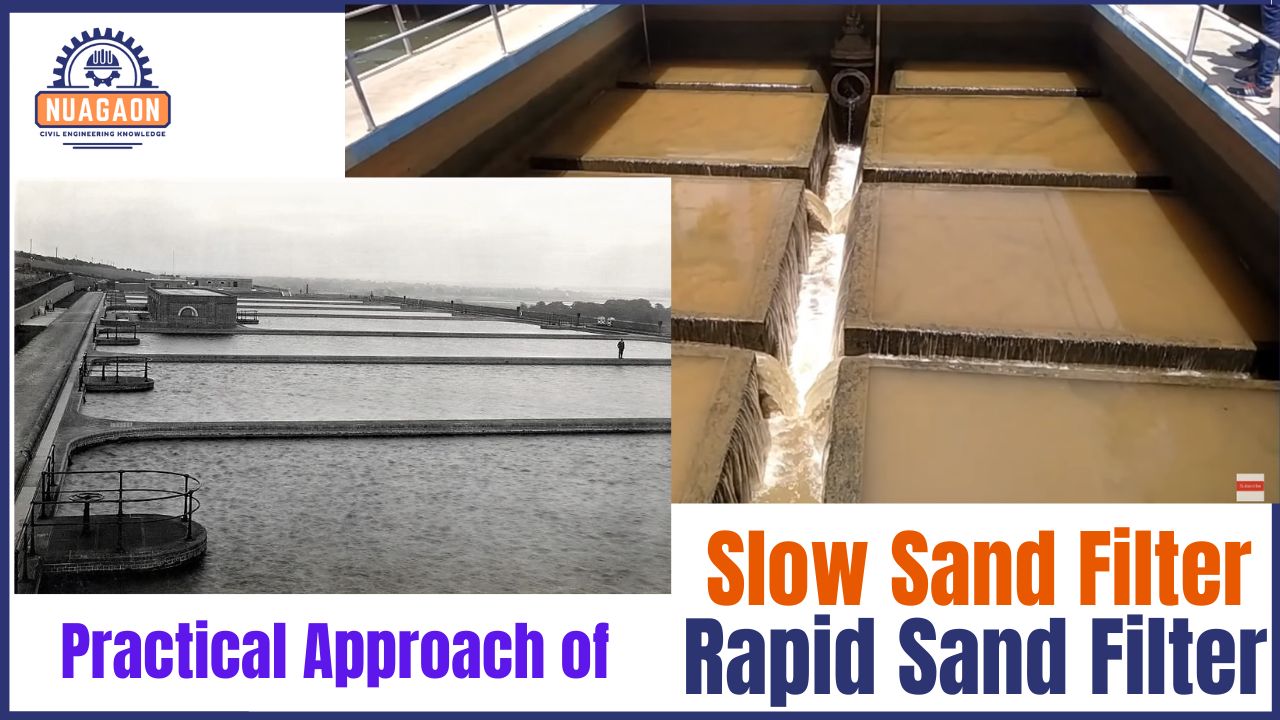Here in this blog, you’ll get to know about the Practical knowledge of Slow sand filter and rapid sand filter. This will help you know the important factors and installation criteria of the slow sand and rapid sand filter.
for small-scale filtration like in household use, many people use Cant or Aqua water filter but For large-scale filters of water slow sand and rapid sand filters are used.
Slow Sand Filter
We call it different Names like Slow Sand Filtration, Sand Filtration Method, Sand Filtration, and Biological Filtration.
Slow sand filtration is an effective water treatment process and a sustainable water management system. This prevents the spread of gastrointestinal diseases. It’s a centralized and semi-centralized water purification system.
It’s installed for Medium-sized, Rural Communities with fairly good quality of the initial surface water source because it’s a chip and easily available. Methods are simple even though no electricity is required. it works by the means of the Natural method.
Process Based on- Ability of Organisms to remove pathogens.
Tank Depth should be – 0.6 m to 1.2 m
Simple working process- A Bigger tank where layers of sand lay. Water is manually or through the Pipe poured into the tank and through the sand layers water gets filtered (Physically or Biologically) and finally collects treated water in the outlet tank.
Principle of Slow Sand Filter
The slow sand filtering process Can divide into 4 Component-
1. Supernatant (Raw) Water
The depth of the supernatant water should be 1 m to 1.5 m filled. It provides a constant head to promote the downward flow of water or to give pressure or push water in the downward direction. Also, provide a waiting period of 3 to 12 Hours which helps to undergo purification by sedimentation and oxidation. You know that up to 90 % of impurities settle down after sedimentation, so this is the important chamber for the slow sand filter.
2. Sand Bed
It must be a depth of up to 1 m. The sand grains’ diameter should be 0.30 mm and supported by the Layer of Graded Gravel. Here, the rate of filtration would be 0.1 to 0.4 m3/h/m2 of the sand surface.
Vital Layer- in the slow sand filter, the surface of the filter gets covered with a slimy growth known as the Schmutzdecke/ Vital/Zoogleal/Biological Layer which extends 3 cm into the top portion of the sand bed. This layer consists of Algae, Bacteria, Plankton, and Diatoms which look like a Slimy gelatinous layer.
It is also known as the Heart of the slow sand filter because, in the slow sand filter, the water can be only used after the formation of a vital layer. It also removes organic matter & oxidizes ammoniacal nitrogen into nitrates.
3. Under the drainage system
It is the mess of Pipes laid under the sand beds. These are perforated pipes laid in the lateral which provide outlets to the filtered water. It also provides support to the sand beds so that the bed must stand to filter the raw water.
4. Filter Control
It is equipped with Valves & Devices to maintain a constant rate of filtration. Which Controls the Rate of Filtration that determines how much water is released and how much water is stored.
Devices like Venturi-metre which works to measure sand bed Resistance/Loss of head
When it exceeds 1.3 m it is uneconomical to run the Filter. After knowing these results the officials know that the filter to wash or no more efficient to provide clean water.
Slow sand Filter Cleaning
First, the supernatant water is cleaned off. The second thing is cleaned by scraping the top portion of the sand depth up to 2 m (Vital layer). Earlier it was 2-3 m deep. After that, 20-30 times Scrapping, the plant is closed down and a new bed is constructed.
In the slow sand filter, Contaminated water flows through a layer of sand, where it gets physically filtered and biologically treated. Hereby, both sediments and pathogens are removed.
Effectiveness of slow sand filter
Highly effective for Bacteria, Protozoa, Viruses, Turbidity, Heavy Metals (Zn, Cu, Cd, Pb)
Somewhat Effective for Odour, Taste, Iron & manganese, Organic matter, and Arsenic
Not Effective for Salts, Fluoride, and the majority of chemicals.
Advantages of Slow Sand Filter
- Effective for removal of bacteria, Viruses, Protozoa, turbidity, and heavy metals.
- Construction, Operation, and maintenance only require basic skills and minimal effect
- A long lifespan is estimated at more than 10 years.
- The physical, Chemical, and biological quality of filter water is very high.
- Easy to install in Rural, semi-urban, and remote areas
- No necessity for the application of chemicals.
- High Reliability and ability to withstand fluctuations in water quality.
- Removes total bacteria count by 99.9 %.
Disadvantage
It works slowly and takes more surface area than can only be possible in rural areas.
Important Factors of Slow Sand Filter
- This has Low rate of filtration = 100 -200 L/h/m2
- Surface area should be = 200-2000 m2
- Total depth should be=3-3.5 m
- Pre-treatment is not required
- Post-treatment is optional on the site
- Sand Filter Characteristic- Where grain size should be 0.20 mm to 0.40 mm and Coefficient of uniformity (Grain)-1.8 to 2.5
Rapid Sand Filter /Mechanical Filter
In this segment, you’ll see the practical application of valve operation, components, and water flow direction. Here we are clearly explaining the component, filtering process, and valve operation of a rapid sand filter. We will include backwash in a separate Blog.
The Rapid sand filter is categorized into two types
Gravity Filter (Paterson’s Filter)
Pressure Type (Candy’s Filter)
Here are the steps to follow while construction. After following the 4 Steps the water gets cleaned in the 5th process.
Coagulation
Alum (Fitkari) is mixed in the raw water with 5 mg/L in the coagulation and then sent to the mixing chamber.
Rapid Mixing
In this tank, Violent agitation takes place.
Flocculation
Slow and gentle stirring of treated water in the flocculation chamber for 30 Minutes. It results in the formation of a Thick, copious, white flocculent precipitate of aluminum hydroxide.
Sedimentation
leave the water for 6 Hours. In this tank, flocculent precipitate along with the Impurities and bacteria and all other things settle down.
Filtration
Partly clarified water is now subjected to the rapid sand filter. The filter bed consists of Sand, Gravel, and Perforated Pipes.
The alum flock which is not removed by the sedimentation is held back on the sand bed and forms a slimy that absorbs bacteria and oxidizes ammonia (Layer as Vital layer).
It formed after following the above steps. That’s why the rapid sand filter is known as the mechanical filter. The clean water flowed to the perforated pipes and we got the clean water.
The rate of filtration of a rapid sand filter is 5 m3/h/m2
When the loss of head approaches 7-8 Feet, Filtration is stopped and filters are subjected to Backwashing.
Filtration Process
The flow of water in the filtration tank is from top to bottom through filter media or in a Downward direction.
Filtration is carried out to remove bacteria, suspended & colloidal impurities, iron & manganese, color, and odor, and to make water sparkling.
Components of RSF
Filter Media- Number Pipe 1 Through which Impure water is entered
Pipe No 4- Where filtered water is collected for the distribution system
Pipe Number-5 for the backwash Water pipe at the other side of the wall attached to
Working under a drainage system
Open Valve 1 and 4, all other valves closed
Filter media Removes Particles and impurities Under the drainage system receive and delivered filtered water and finally Open Valve 4 to collect water.
Where pipe and strainer type of under drainage system installed. In the middle Central Drain exists and also, and there are lateral drain strainers installed
Rapid Sand Backwashing process
The flow of water in the filtration tank is from bottom to top or in an upward direction through filter media.
Where the upward direction of the flow of water takes place to remove dirt and blockages from the filter media.
Rapid sand filter- Backwashing Reversing the flow of water. Sometimes air is used.
Two things are required for the backwashing-
- Wash water– A overhead water tank is provided near the filter House to store water required for the backwashing of the filter bed.
- Compressed air- Compressed air and wash water are forced to flow in the upward direction through sand and gravel layers which are reverse flow. Because of this all the dirt removes and will move to the top level of the filtration tank. And the wastewater is removed from the outlet valve Pipe Number 5.
Back air Pressure apply under the filter bed
Advantage of Rapid sand filter-
- It occupies less space
- Filtration is Rapid in the Rapid sand filter
- Washing is easy in the rapid sand filter
Here are the More Advantage to Read- READ NOW!
Important Factors of Rapid Sand Filter
- Rate of filtration= 3000-6000 L/h/m2
- Surface area required= 80-200 m2
- Depth should be = 2.5 to 3 m2
- Pre-treatment is compulsory
- Sand filter characteristic (Grain size)- 0.35 mm to 0.55 mm
- Coefficient of uniformity (Grain)- 1.2 to 1.8
How much time would it take to backwash water?
7 to 10 minutes with an additional flow of air.
Water Treatment Plant- 100 % Practical Approach, Site Images, Basic Process
Hope the above article on slow sand filter and rapid sand filter will help to know the practical approach. if anything in your mind regarding this, comment!




